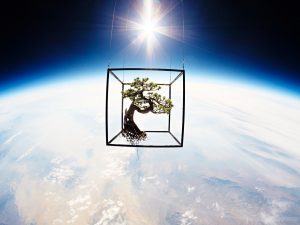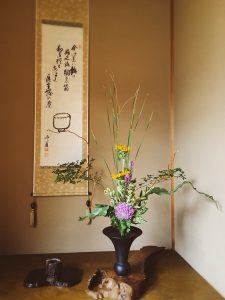by Leanne Ogasawara

I once lived in a town famous for plum blossoms.
To get there, you have to board an express train out of the busiest train station in the world. The view out the window won’t impress you all that much either; as Tokyo sprawls endlessly gray outward from the center. After about 30 minutes, you will notice the train crossing a bridge over a river (the unmistakable rhythmic sound will alert you even if you’ve closed your eyes). This is your cue to get ready to hop off at the next station; for there, on the western shore of the Tama River, you will need to change to a local train.
And from there, it is just one more stop.
Mogusaen. Its name means, “garden of a hundred grasses” (百草園). A sleepy little neighborhood not even large enough to merit an express stop on the Keio Line, Mogusaen would make the TV news every February, when something incredible happened. How to describe those fragile-looking plum flowers blooming defiantly in the snow? Especially at night, the pale flowers on frozen trees branches would shimmer in the moonlight. It was enchanting.
So splendid were the plum blossoms of Mogusean that blossom-viewers would travel from far and wide just to see them every year. In fact, such was the rush of people that the entire Keio Line train network would have to be reorganized to turn Mogusaen into an express stop for the several weeks when the plum trees were in bloom. During this brief period, huge crowds used to stream in on the express train to go plum blossom-viewing.
But all too soon, the flowers would fade– and Mogusaen reverted back to its ordinary incarnation of sleepy, little local stop again. Even now, I still can’t help but smile when I think of how those flowers commanded the complete rescheduling of one of Tokyo’s busiest train lines!
Most people when they think of Japan, probably don’t first conjure up romantic images of plum trees since it has always been the cherry blossoms which have made Japan so famous. When I first arrived in Tokyo–just a few weeks after my 21st birthday, it was Easter Sunday– just weeks before the sakura burst into beautiful bloom. I had never seen anything like it before. It was as if the entire city was completely drunk on flowers. I don’t think in many other places in the world you could find quite so much activity surrounding a blossoming tree—no matter how beautiful. Trains change their schedules to facilitate easier blossom-viewing, as the whole country becomes mobilizes into flower-viewing mode. During weekdays, business people gather under the blossoms for long lunches with beer and karaoke and at night there are even more parties—as cherry blossoming-viewing by moonlight is considered to be the ultimate way to enjoy the arrival of spring. So anticipated are the cherry blossoms that most people refer to them simply as “o-hana,” meaning flower (as if no other flower counted!)
Everyone should experience this once in their life.
But I like to remind people that cherry blossoms are not the only game in town!
 ++
++
I used to love watching my tea teacher arranging flowers. Though all the women in my teacher’s family had been tea ceremony teachers for five generations back, Shiraishi sensei was particularly well-known in our town for ikebana; for she was a celebrated master at chabana (茶花), the flowers used to decorate the tokonoma alcove in the tea room. My sensei loved flowers like no one I had ever met. Chrysanthemums, begonia, almond blossoms, sweet osmanthus, lotus, banana and palm–not to mention all the usual suspects. What do you think were her favorites? She used to always repeat it like a mantra:
Plum blossoms in winter and peonies in spring.
Every spring, her garden would be transformed into a fairyland. An explosion of dazzling magenta, with waist-tall peony bushes heavy under the weight of giant peony blossoms, each flower the size of a small child’s head. Some were shaded from the sun by paper parasols she placed here and there in sunny parts of the garden. My teacher taught me that flowers are admirable; for not only are they beautiful and generate feelings of joy, but they also symbolize strength and nobility of character– attributes that we can all learn from. When a flower blooms, it either blooms in its fullest capacity and with all its might, or it’s a dud. No half measures for flowers.
Under my sensei’s influence, I also happen to prefer plum blossoms in winter and peonies in spring.
But there is one more flower that I dearly love-maybe even more than all the others. And this happened to also be a flower that people flocked to my neighborhood to see every year. This time, in early summer, when people traveled from far and wide to see the famed hydrangea flowers of Takahatafudoson Temple.
What a name right?
Takahatafudo Temple is one of the most important Shingon Temples in the Tokyo area. Have you ever heard of Shingon Buddhism (真言宗)? I never had before moving to Mogusaen. In fact, I was very surprised the first time I found myself inside a Shingon temple. Being American, I had imagined all the temples in Japan would be Zen temples. But stepping inside a Shingon temple is like stepping into another world. And that world is Tibetan!
Before coming to Japan, I had marveled at Tibetan Buddhist temples in the Himalaya –but never expected to find one in Japan. And yet inside Takahatafudo temple I saw those same colorful mandalas and statues of Tantric deities that aided Tibetan pilgrims on the path toward enlightenment that I had seen in those towering mountains so far to the west in India and Nepal. The defender deity “Fudo” (不動明王) is contained in the temple’s name. Depicted surrounded by flames and much like the ritual Tibetan Buddhist thunderbolt (the Vajra), this wrathful deity is said to cut through people’s ignorance and delusions…. Yes, he is a Buddhist slayer of evil.
Here is a question: Are profound religious truths accessible to common people without lengthy instruction? Or is there a storehouse of secret teachings (密教) that can spark immediate enlightenment, which has been passed down since the time of the Shakyamuni Buddha? Kukai, the founder of the Shingon school, believed the latter and these mandala and statues of various Bodhisattva were esoteric means for allowing the pilgrim’s mind to visualize levels of truth that one could not express in words, thereby allowing our ignorance to be cut, ripping away the veil that hides the truth.
Kukai said that the secret teachings of Shingon became seeds in the believer’s heart–for they have the power to blossom there; for we can know our own hearts and understand truth.
But Takahatafudo Temple is not just famous for its mandalas and statues; for the temple happens to be one of the best places in Tokyo to see hydrangea flowers.
In Japanese, the word for hydrangea is ajisai (紫陽花). And the three Chinese characters used to write the word are: “purple,” “sun” “flowers.” Phonetically, the word probably derived from the ancient Japanese word for “indigo,” indicating either the blue-purple color of the flowers or the plants used for dying cloth blue. At Takahatafudo, there are some 7,500 hydrangea plants growing wildly across the temple garden. It is like an ever-expanding universe of brilliant blue and purple galaxies blossoming in all directions –as far as the eye can see behind the pagoda. People would come from all over Tokyo to see the flowers every June. I was lucky– since it was only a short walk along the river to the temple from my apartment.
And I went religiously to see them every June during the long rainy season in Japan.
One year, after I was approaching the end of my first decade in Japan, something funny happened. As I was walking around the back of the pagoda toward the flowers, I came up behind a mother who was lovingly picturing in words –in the the gentlest possible voice to her son– everything she saw. He was blind, and she was holding his hand as he carefully stepped along the narrow path with his cane. She was describing how huge the flowers were and how some were still covered in raindrops after the morning’s rain shower. I decided to walk around them, and as I passed I heard her telling him that it wasn’t just the flowers that needed describing, because would you believe a foreigner was here amongst the blossoms–and she proceeded to portray me in great detail to the boy—including my frizzy hair and very clumsy way of walking!
I smiled and thought, “I will never forget this place…”
I was so young. Now I realize that there are moments in our lives that become inscribed in our hearts. And it is in the telling of them that we glimpse and know –we remember—something of a feeling of the beautiful and the sacred (幽玄). That something known, glimpsed, remembered. For on that early summer’s day, as I gazed upon the simple and sheer beauty of innumerable blue flowers unfolding in every direction – a most Japanese thing to observe and delight in – I found myself staring at a microcosm of the universe.
And as it turned out, I was part of it–for the universe was staring back at me.
–For my son, on the eve before he returns to Japan for the first time since we left in 2011.
Pictures ofJapanese artist Makoto Azuma’s arrangements for “space”
